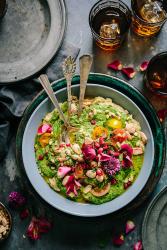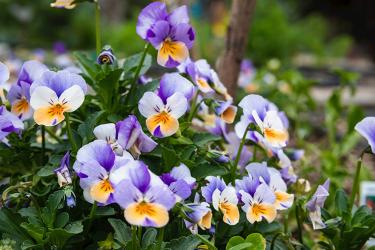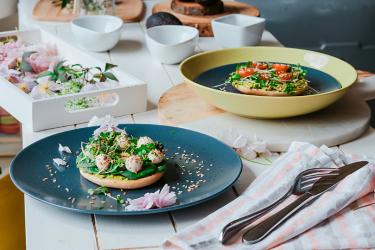With April showers come spring flowers, and the abundance of colorful blooms are sure to spark inspiration in the kitchen. For many gardeners, eating from the garden means eating vegetables such as tomatoes, carrots or cucumbers, but it doesn’t have to stop there! Edible flowers are a great way to incorporate color into your everyday meals.
Before you venture into the world of edible flowers, it is important to remember to be extremely careful when incorporating flowers into your meals. Some flowers are highly toxic and inedible, there’s also the risk of potential contamination if an edible flower has come into contact with an inedible flower. One of the best ways to ensure the flowers you’re eating are safe is to cultivate your own garden of edible flowers.
A common way to incorporate flowers into your diet is as a garnish. Take your morning toast to the next level with some borage, an herb with blue flowers, or sprinkle a few rose petals into your ice cream. For those looking to experiment in the kitchen, flowers, like lavender or pansies, can be added to baked goods for an extra splash of color. Once you’ve decided how you want to use edible flowers, it makes it easy to determine which type of seeds you need to buy to start your own garden, as well as the best spot to begin your new gardening adventure. For example, nasturtium seeds grow best when soaked for 24 hours and then planted in moist, warm soil. On the other hand, squash blossoms are grown by planting zucchini seeds and grow best when harvested frequently.
When it comes time to prep your flowers, the easiest way is to give them a quick rinse in room temperature water and then pat dry with a paper towel. If you’re dealing with more delicate flowers, you can give them a quick wipe with a towel to remove any dirt from the petals. The flowers also need to be cleaned before use to help reduce exposure to pollen living on the stems. If you’re prepping the flowers for later, wrap them in a damp cloth and store them in the fridge. It’s important to note that most flowers are best right after being harvested; if left for too long they can lose their shape and grow mold.
Experimenting with edible flowers is a fun way to welcome the warmer months and dive headfirst into spring. Whether you’re planting your first lavender seeds or frying your first squash blossom, edible flowers will help you grow your gardening skills and expand your culinary tastes.
Flavorful Flora
Curious about adding flowers to your everyday meals? Here’s a look into some of the most popular floral flavor profiles.
Roses: strawberry and green apple flavor
Marigold: notes of citrus and pepper
Butterfly Pea (when in tea): mildly sweet floral flavor
Borage: cucumber-like taste
Nasturtiums: peppery, spicy flavor
Pansies: mild flavor with a slight sweet taste
Squash blossom: mild flavor that’s similar to squash, when uncooked can taste like a sweet radish











